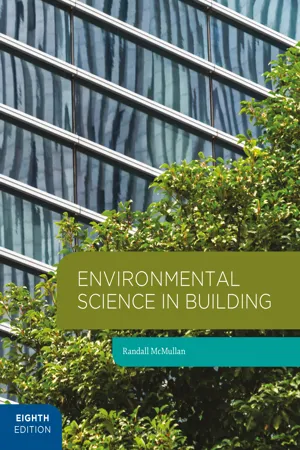
- 399 pages
- English
- ePUB (mobile friendly)
- Available on iOS & Android
eBook - ePub
Environmental Science in Building
About this book
This popular textbook covers how the built environment and the management of energy relate to the quality of human living-conditions and the environmental performance of buildings. It is the key introductory text for understanding the principles and theories of the environmental science behind construction, and the only text on the market to provide the basic scientific principles of such a broad range of topics. The text covers a range of areas in the field, including climate change, energy management, and sustainability in construction, with an important focus on contemporary environmental topics such as carbon, lifetime performance and rating schemes. The author is known for his extremely clear, finely crafted text, and the book offers a wealth of excellent worked examples.
This text is designed to be useful, at all levels, to students and practitioners of architecture, construction studies, building services, surveying, and environmental science.
New to this Edition:
- Expansion upon the environmental narrative with coverage of contemporary topics such as carbon, lifetime performance and rating schemes
- Additional figures, images and sub-topics in chapters
- An updated section on building services to give a broader understanding of modern building services equipment options, specifications and performance implications
- Inclusion of a new section which offers commentary on the future of environmental science in building
This text is designed to be useful, at all levels, to students and practitioners of architecture, construction studies, building services, surveying, and environmental science.
New to this Edition:
- Expansion upon the environmental narrative with coverage of contemporary topics such as carbon, lifetime performance and rating schemes
- Additional figures, images and sub-topics in chapters
- An updated section on building services to give a broader understanding of modern building services equipment options, specifications and performance implications
- Inclusion of a new section which offers commentary on the future of environmental science in building
Frequently asked questions
Yes, you can cancel anytime from the Subscription tab in your account settings on the Perlego website. Your subscription will stay active until the end of your current billing period. Learn how to cancel your subscription.
No, books cannot be downloaded as external files, such as PDFs, for use outside of Perlego. However, you can download books within the Perlego app for offline reading on mobile or tablet. Learn more here.
Perlego offers two plans: Essential and Complete
- Essential is ideal for learners and professionals who enjoy exploring a wide range of subjects. Access the Essential Library with 800,000+ trusted titles and best-sellers across business, personal growth, and the humanities. Includes unlimited reading time and Standard Read Aloud voice.
- Complete: Perfect for advanced learners and researchers needing full, unrestricted access. Unlock 1.4M+ books across hundreds of subjects, including academic and specialized titles. The Complete Plan also includes advanced features like Premium Read Aloud and Research Assistant.
We are an online textbook subscription service, where you can get access to an entire online library for less than the price of a single book per month. With over 1 million books across 1000+ topics, we’ve got you covered! Learn more here.
Look out for the read-aloud symbol on your next book to see if you can listen to it. The read-aloud tool reads text aloud for you, highlighting the text as it is being read. You can pause it, speed it up and slow it down. Learn more here.
Yes! You can use the Perlego app on both iOS or Android devices to read anytime, anywhere — even offline. Perfect for commutes or when you’re on the go.
Please note we cannot support devices running on iOS 13 and Android 7 or earlier. Learn more about using the app.
Please note we cannot support devices running on iOS 13 and Android 7 or earlier. Learn more about using the app.
Yes, you can access Environmental Science in Building by Randall McMullan in PDF and/or ePUB format, as well as other popular books in Technology & Engineering & Sustainability in Architecture. We have over one million books available in our catalogue for you to explore.
Information
Edition
8Subtopic
Sustainability in ArchitecturePart I
Core Topics

1
The Environment
It is remarkable to see a ‘big picture’ view of our environment, such as the entire planet Earth photographed from outer space. Against the darkness of space the Earth’s surface is lit by the Sun, that crucial star that governs our planet and supplies it with energy. It is also challenging for us to consider that the Sun and the Earth, like other planetary systems, can happily exist without the current range of life on Earth, including us humans. Compared to such matters, this book has a relatively limited scope!
Used in a broad sense, the term environment means the global surroundings that affect our lives. This is obviously a large and complex topic involving factors that range from big events on the Sun to small events within the molecules of living organisms. Many environmental factors also interact with one another in ways that are important, or even vital to life. For example, the oxygen content of the atmosphere is regulated by the plants of the Earth which take up carbon dioxide from the air and then give back oxygen, which we breathe.
Maintaining and improving the quality of our environment is important to life and to the quality of life. Environmental topics can also have important social and political dimensions with difficult choices to be made and issues to be debated. Added to this, the science and technology of the different topics have many interactions and links which can be difficult to understand.
This book focuses on the science, technology and services relating to the comfort of humans in buildings and the environmental performance of those buildings. These aspects of the built environment have many significant interactions with the wider environment and a secure knowledge of facts, terms and principles is a good basis for understanding the environment.
Overarching environmental matters, such as climate and comfort, are considered in this chapter while later chapters examine topics in more detail. The Resource sections of the book contain supporting information that can be used to review the science behind some of the technologies studied and for the further investigation of topics.
ENVIRONMENTS
Basic terms
The components that make up the wider environment can be subdivided according to various systems, but a major distinction for this book is the difference between the natural environment and the built environment.
•Natural environment is the entire environment, without human presence or interference.
Notable features of the natural environment include climate, mountains and hills, rivers and lakes, rocks and soil, trees and plants.
•Built environment is formed by the buildings and other structures that humans construct in the natural environment.
Notable features of the built environment include buildings, water and drainage systems, transport systems, power systems, and communication systems.
•Sustainability is the general idea of meeting the needs of the present without compromising the needs of the future. It is about enduring.
•A green or sustainable building is deliberately designed to minimise impact on the natural environment and to maximise efficiency in the use of resources such as materials, water and energy over the lifecycle of the building.
Related ideas: Green architecture Sustainable architecture Natural building Ecological building Environmental building
Although this book focuses on the environment in and around buildings, there is considerable interaction between different environmental factors, as shown in the simple model of Figure 1.1.

Figure 1.1 Parts of the environment
Connections between environments
From the earliest times, people have adapted their habitat to provide shelter from the weather and other threats to life. Early humans made use of natural shelters, such as caves, and then they built shelters using available materials like animal hides, stones, straw, or wood. Modern buildings involve so many features in design, materials and construction that it is easy to forget that the fundamental aim is to provide an internal environment that is different from the external environment. A built environment responds to the local natural environment, and different types of building are therefore found in different parts of the world. Climate is a major factor in determining the features of building, together with the availability of building materials and skills. Some of these interactions are summarised in Table 1.1. Other influences on types of building are local traditions and international architectural styles.
Vernacular means the local style
Interactions and issues
Some of the interactions between the built and natural environments have effects that cause concern:
•consumption of non-replenishable resources such as fossil fuel
•consumption of resources without replacement, such as hardwood forests
•harmful changes to local habitat, such as deforestation
•harmful changes to global habitat, such as climate change.
Table 1.1 Examples of environmental connections
Natural environment features | Built environment features |
Hot, d... |
Table of contents
- Cover
- Halftitle
- Title
- Copyright
- Contents
- List of Figures
- List of Tables
- Preface
- How to use this book
- Acknowledgements
- Part I Core Topics
- Answers to exercises
- Part II Resources
- Index